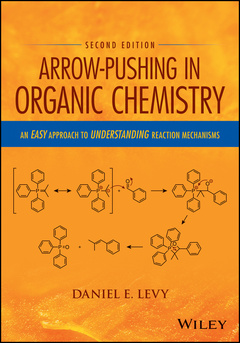Arrow-Pushing in Organic Chemistry (2nd Ed.) An Easy Approach to Understanding Reaction Mechanisms
Auteur : Levy Daniel E.

? Includes new chapters, an expanded index, and additional problem sets complete with detailed solutions
? Focuses on understanding the mechanics and logic of organic reaction mechanisms
? Introduces ionic and non-ionic reactive species and reaction mechanisms
? Teaches strategies to predict reactive species, sites of reactions, and reaction products
? Provides a solid foundation upon which organic chemistry students can advance with confidence
PREFACE xi
ACKNOWLEDGEMENTS xiii
ABOUT THE AUTHOR xv
1. Introduction 1
1.1 Definition of Arrow-Pushing 1
1.2 Functional Groups 5
1.3 Nucleophiles and Leaving Groups 7
1.4 Summary 8
Problems 9
2. Free Radicals 19
2.1 What Are Free Radicals? 19
2.2 How Are Free Radicals Formed? 21
2.2.1 Free Radical Initiators 22
2.2.2 Electron Transfer 23
2.3 Free Radical Stability 23
2.4 What Types of Reactions Involve Free Radicals? 25
2.4.1 Halogenation Reactions 26
2.4.2 Polymerization Reactions 28
2.4.3 Oxidation Reactions 30
2.5 Summary 31
Problems 32
3. Acids 37
3.1 What Are Acids? 37
3.2 What Is Resonance? 38
3.3 How Is Acidity Measured? 41
3.4 Relative Acidities 42
3.5 Inductive Effects 47
3.6 Inductive Effects and Relative Acidities 49
3.7 Relative Acidities of Hydrocarbons 50
3.8 Summary 51
Problems 52
4. Bases and Nucleophiles 61
4.1 What Are Bases? 61
4.2 What Are Nucleophiles? 66
4.3 Leaving Groups 70
4.4 Summary 70
Problems 71
5. SN2 Substitution Reactions 81
5.1 What Is An SN2 Reaction? 81
5.2 What Are Leaving Groups? 83
5.3 Where Can SN2 Reactions Occur? 84
5.4 SN2′ Reactions 85
5.5 Summary 88
Problems 89
6. SN1 Substitution Reactions 97
6.1 What Is An SN1 Reaction? 97
6.2 How Are SN1 Reactions Initiated? 98
6.3 The Carbocation 99
6.3.1 Molecular Structure and Orbitals 100
6.3.2 Stability of Carbocations 103
6.4 Carbocation Rearrangements 105
6.4.1 1,2-Hydride Shifts 105
6.4.2 1,2-Alkyl Shifts 106
6.4.3 Preventing Side Reactions 109
6.5 Summary 109
Problems 110
7. Elimination Reactions 115
7.1 E1 Eliminations 115
7.2 E1cB Eliminations 118
7.3 E2 Eliminations 120
7.4 How Do Elimination Reactions Work? 121
7.5 E1cB Eliminations Versus E2 Eliminations 124
7.6 Summary 124
Problems 126
8. Addition Reactions 133
8.1 Addition of Halogens to Double Bonds 133
8.2 Markovnikov’s Rule 135
8.3 Additions to Carbonyls 137
8.3.1 1,2-Additions 137
8.3.2 1,4-Additions 138
8.3.3 Addition–Elimination Reactions 141
8.4 Summary 143
Problems 144
9. Carbenes 153
9.1 What Are Carbenes? 153
9.2 How Are Carbenes Formed? 154
9.3 Reactions with Carbenes 156
9.3.1 Carbene Dimerization 156
9.3.2 Cyclopropanation Reactions 157
9.3.3 O-H Insertion Reactions 161
9.4 Carbenes Versus Carbenoids 162
9.5 Summary 163
Problems 164
10. Pericyclic Reactions 171
10.1 What Are Pericyclic Reactions? 171
10.2 Electrocyclic Reactions 172
10.3 Cycloaddition Reactions 175
10.3.1 The Diels–Alder Reaction 175
10.3.2 The Ene Reaction 178
10.3.3 Dipolar Cycloaddition Reactions 180
10.4 Sigmatropic Reactions 182
10.4.1 The Cope Rearrangement 183
10.4.2 The Claisen Rearrangement 184
10.5 Summary 187
Problems 189
11. Moving Forward 195
11.1 Functional Group Manipulations 195
11.2 Name Reactions 196
11.3 Reagents 208
11.4 Final Comments 208
Problems 209
Appendix 1. pKa Values of Protons Associated with Common Functional Groups 219
Appendix 2. Answers and Explanations to Problems 223
Chapter 1 Solutions 224
Chapter 2 Solutions 234
Chapter 3 Solutions 241
Chapter 4 Solutions 258
Chapter 5 Solutions 270
Chapter 6 Solutions 285
Chapter 7 Solutions 293
Chapter 8 Solutions 303
Chapter 9 Solutions 318
Chapter 10 Solutions 334
Chapter 11 Solutions 347
Appendix 3. Student Reaction Glossary 369
Index 373
Periodic Table of Elements 401
DANIEL E. LEVY, PhD, is the owner of DEL BioPharma LLC, USA. He previously worked at Glycomed, COR Therapeutics, Scios, and Intradigm. Dr. Levy developed, with Dr. Péter Fügedi, short courses entitled "Modern Synthetic Carbohydrate Chemistry" and "The Organic Chemistry of Sugars." He has three books to his credit, including the rst edition of Arrow-Pushing in Organic Chemistry (Wiley, 2008). He received his bachelors in chemistry from the University of California Berkeley and his doctorate in organic chemistry from the Massachusetts Institute of Technology.
Date de parution : 03-2017
Ouvrage de 424 p.
17.5x25.2 cm



